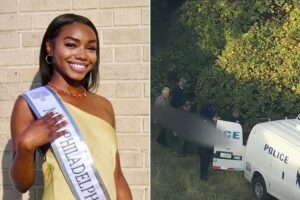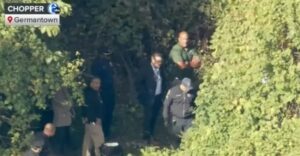In a chilling development that has gripped the nation, investigators in the tragic case of 23-year-old Kada Scott have uncovered what they describe as a potential “smoking gun” in the form of never-before-seen surveillance footage from a nondescript gas station camera. The video, timestamped just hours after Scott vanished on October 4, shows a dark SUV pulling up alongside her abandoned vehicle for precisely 1 minute and 12 seconds. In a sequence that has forensic experts buzzing, both vehicles’ brake lights flash twice in rapid succession—a maneuver authorities now believe was a deliberate, coded signal between the driver of the SUV and an unseen accomplice inside Scott’s car.

The footage, obtained from a Shell station on Germantown Avenue in Northwest Philadelphia, was reviewed as part of an exhaustive re-canvassing effort by the Philadelphia Police Department’s Homicide Unit. Sources close to the investigation, speaking on condition of anonymity, revealed that the clip was nearly overlooked amid the flood of tips and videos pouring in since Scott’s remains were identified last week. “This isn’t just random traffic,” one investigator told reporters off the record. “The timing, the precision—it’s too coincidental. We’re treating it as evidence of coordination.”
Kada Scott, a bright and ambitious nursing assistant studying at Penn State University, disappeared under mysterious circumstances during what should have been a routine overnight shift at The Terrace at Chestnut Hill, an assisted living facility in the upscale Chestnut Hill neighborhood. Described by her family as a “beacon of light and kindness,” Scott had borrowed her mother’s silver Hyundai Elantra to drive to work that evening, arriving around 9:45 p.m. Court documents and witness statements paint a picture of a young woman already on edge: in the days leading up to her vanishing, Scott had confided in friends and family about receiving a barrage of harassing phone calls from an unknown number. “She was scared,” her father, Kevin Scott, said in an emotional interview shortly after her disappearance. “She told us someone was bothering her, but she didn’t want to worry us. We should have pushed harder.”

By 10 p.m., a coworker spotted Scott stepping outside the facility for what she assumed was a quick break. The colleague overheard a heated phone conversation—”I can’t believe you’re calling me about this [expletive]”—before Scott walked toward a dark-colored SUV idling in the employee parking lot. That vehicle, now believed to be the same one captured on the gas station footage, sped away with Scott inside, according to preliminary analysis. Her Hyundai was later found abandoned in the lot, keys in the ignition, but her personal items—iPhone, iPad, and Apple Watch—were nowhere to be seen. The Apple Watch’s last ping placed it briefly in the vicinity before going dark, a digital breadcrumb that would later lead detectives to a wooded area behind the abandoned Ada H.H. Lewis Middle School in East Germantown.
The search for Scott quickly escalated into one of Philadelphia’s most high-profile missing persons cases of the year. Within days, the Philadelphia Police Department deployed K-9 units, drones, and helicopters to scour Awbury Arboretum and surrounding neighborhoods, turning up nothing but frustration. By October 14, the case had been handed over to the Homicide Unit—a grim indicator of investigators’ fears. Tips flooded in, including anonymous leads that grew increasingly specific: one claimed to have seen a “suspicious figure” dumping items near the old school; another described a gold Toyota Camry with tinted windows cruising the area erratically.
These leads converged on 21-year-old Keon King, a South Philadelphia resident with a troubling history. King, who had been in sporadic contact with Scott via cellphone in the weeks prior, was arrested on October 15 and charged with kidnapping, reckless endangerment, and related offenses. Prosecutors allege that King, driving a stolen Hyundai Accent reported missing on October 3, arranged to meet Scott outside her workplace under false pretenses. Surveillance from the facility shows the dark SUV—matching the gas station footage—pulling up at 10:02 p.m., with Scott approaching the passenger side. “Cellphone data places King at every critical location,” Assistant District Attorney Ashley Toczylowski stated during a tense press conference on October 20. “From the abduction site to the disposal area, his phone was there.”

The breakthrough came on October 19, when search teams unearthed human remains in a shallow grave behind the middle school—Scott’s debit card and a phone case clutched in the dirt nearby. DNA confirmation followed swiftly, ruling her death a homicide by the Philadelphia Medical Examiner. But it was the gas station video, recovered just days ago from a backup hard drive at the station, that added a layer of intrigue. The footage, grainy but timestamped at 11:14 p.m. on October 4, captures Scott’s Hyundai parked at Pump 3, eerily still. Moments later, the dark SUV—identified by its Pennsylvania plates and distinctive roof rack as King’s—glides in from the access road. It halts parallel to the Hyundai, engines idling. For 1 minute and 12 seconds, nothing overt happens: no doors open, no figures emerge. Then, in unison, both vehicles’ brake lights pulse twice—on, off, on, off—like a Morse code heartbeat.
Forensic video analysts, consulting with the FBI’s Behavioral Analysis Unit, pored over the clip frame by frame. “The synchronization is uncanny,” said Dr. Elena Vasquez, a digital forensics expert at Temple University who reviewed the footage at investigators’ request. “Brake lights don’t flash like that accidentally. In criminal enterprises, especially those involving multiple parties, signals like this are common—quick, deniable, effective. It suggests someone inside the Hyundai was communicating with the SUV’s driver, possibly confirming a handoff or alerting to pursuit.”
This revelation has reopened questions about accomplices. While King remains the prime suspect, held on $2.5 million bail, court documents unsealed this week hint at a broader network. A gold Toyota Camry, traced via the city’s extensive license plate reader system, was spotted leaving the abduction scene and later burning in a remote lot on October 7—King’s phone pinging nearby during the blaze. “We’re not ruling out a third party,” Deputy Police Commissioner Frank Vanore said cryptically during Wednesday’s briefing. “The brake light signal could indicate coordination. Every lead is being chased.”
King’s background only deepens the shadows. Earlier this year, he faced charges in a separate kidnapping case: prosecutors say he snatched a woman from her doorstep, assaulted her in a vehicle, and released her only after she fought back. That case was dropped when the victim failed to appear in court—a decision now under fiery scrutiny from DA Larry Krasner, who called it an “appalling lapse” in his office’s judgment. Refiled charges loom, painting King as a serial predator. A TikTok video surfaced last week, allegedly showing King stalking another potential victim, peering through a window in a chilling echo of Scott’s final moments.
For the Scott family, the footage is both a torment and a torch. Kevin Scott, a stoic father who has led daily vigils outside the police precinct, broke down when shown the clip. “That was my baby in there,” he said, voice cracking. “Flashing lights like some kind of signal? It makes my blood boil. But if it brings justice… we’ll endure.” A GoFundMe launched by relatives has raised over $50,000, earmarked for rewards and legal fees. At Monday’s vigil, attended by City Council President Kenyatta Johnson, mourners lit candles and chanted, “Justice for Kada.” Johnson’s statement captured the city’s outrage: “We must protect our women, demand accountability. No more shadows.”
The investigation presses on, with analysts now cross-referencing the SUV’s movements against traffic cams and witness sketches. Public tips have surged—over 200 since the footage leaked to local media—pouring into a dedicated hotline (215-686-3353). Community leaders, including pastors from Germantown’s Bethel AME Church, have formed task forces to support families like the Scotts, emphasizing mental health resources amid the grief.
As Philadelphia grapples with this loss, the gas station footage stands as a haunting symbol: technology’s double edge, capturing evil in pixels while urging us toward light. Kada Scott’s story isn’t just a headline—it’s a call to vigilance, a reminder that behind every missing poster is a life interrupted. Investigators vow closure, but for now, the double flash lingers, a coded plea echoing in the night.



